
When contacting us by e-mail, correspondents are asked to include their name and full postal address and, when providing information, to quote exact book and magazine sources. The word ‘chess’ needs to appear in the subject-line or in the message itself.
| First column | << previous | Archives [31] | next >> | Current column |

The above photograph (Moscow, 1925) comes from page 27 of Shakhmatnaya pravda by S. Tartakower (Leningrad, 1926). As mentioned in the caption, the person standing is N.V. Krylenko.
Javier Asturiano Molina (Murcia, Spain) draws attention to this pair of 25-move games:
Victor Ciocaltea – Július Kozma1 e4 e6 2 d3 d5 3 Nd2 c5 4 Ngf3 Nc6 5 g3 Nf6 6 Bg2 Be7 7 O-O O 8 Re1 Qc7 9 e5 Nd7 10 Qe2 b5 11 Nf1 a5 12 h4 b4 13 Bf4 Ba6 14 Ne3 Ra7 15 h5 Rc8 16 h6 g6 17 Nxd5 exd5 18 e6 Qd8 19 exf7+

19...Kh8 20 Ne5 Nf6 21 Nxc6 Rxc6 22 Qe5 Rd6 23 Bxd5 Bb5 24 Bg5 Bc6 25 Bxc6 Resigns.
Lazaros Vizantiadis – Victor Ciocaltea1 Nf3 c5 2 g3 Nc6 3 Bg2 d5 4 O-O Nf6 5 d3 e6 6 Nbd2 Be7 7 e4 O-O 8 Re1 Qc7 9 e5 Nd7 10 Qe2 b5 11 Nf1 a5 12 Bf4 b4 13 h4 Ba6 14 Ne3 Ra7 15 h5 Rc8 16 h6 g6 17 Nxd5 exd5 18 e6 Qd8 19 exf7+ Kf8 20 Ng5 Bxg5 21 Bxg5 Nf6 22 Bxf6 Re7 23 Qf3 Kxf7 24 Bg7+ Ke8 25 Bh3 Resigns.
Although the move-order was altogether different, the same position was reached after 19 exf7+, and despite winning the first game Ciocaltea lost the second one.
A quote about chess from the Nazi official Hans Schemm (1891-1935):

Our translation:
‘I regard chess as an outstanding educational aid. It is an intellectual battle-game which provides training in reasoning, inventiveness and determination, while also requiring the will for survival and victory. In schools, chess clubs should be set up to cultivate chess outside of school hours.’
Source: Hans Schemm spricht – Seine Reden und sein Werk by G. Kahl-Furthmann (Bayreuth, 1935), page 178.
Below are two photographs of Schemm. The first was published opposite page 192 of Hans Schemm, volume one by Benedikt Lochmüller (Bayreuth, 1935), whereas the picture of him standing alongside Bernhard Rust (1883-1945) appeared in Hans Schemm Ein Leben für Deutschland by Bernd Lembeck (Munich, 1936).
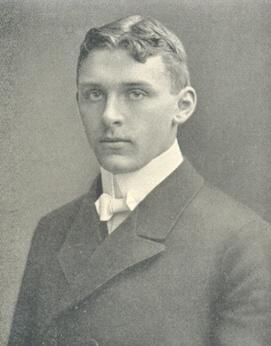
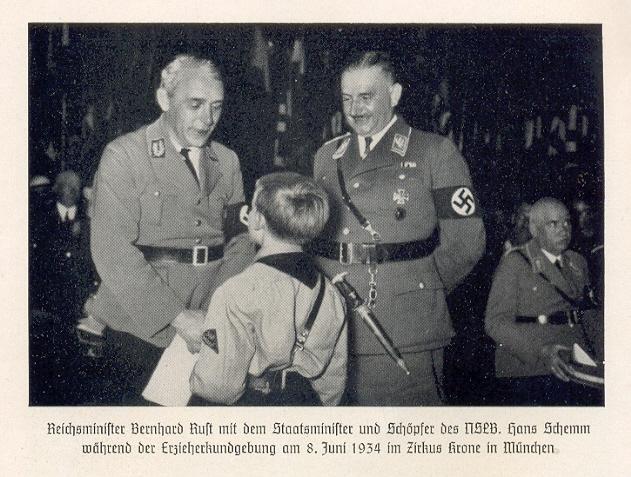
From Avital Pilpel (Haifa, Israel):
‘Was Réti Jewish? Many sources, including some Hebrew-language ones, say that he was, but is reliable corroboration available?’
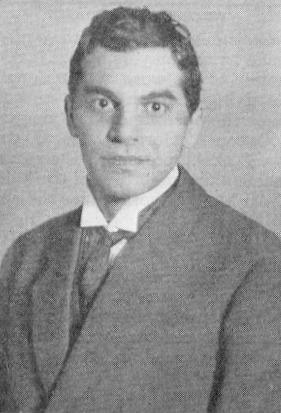
Richard Réti

The above text is reproduced from page 122 of Wonders and Curiosities of Chess by Irving Chernev (New York, 1974). Numerous discrepancies exist in references to this game in popular chess books, and we are grateful to José Antonio Garzón (Valencia, Spain) for summarizing the facts:
‘The game appears in the poem “Scachs d’amor”, Valencia, circa 1475. It is the work of three famous Valencian poets, Bernat Fenollar, Narcis Vinyoles and Francí Castellví. Castellví plays the red (white) pieces and Vinyoles the green (black) ones, while Fenollar is the referee, describing in his interventions the birth of modern chess and providing a first set of rules. The opening is a Centre Counter-Gambit (1 e4 d5 2 exd5 Qxd5), so as to “show” the new piece from the very beginning. The poets describe the movement of the new piece, claiming to have invented it (stanzas 1 and 54), and thus confirming the Spanish origin of modern chess.
The poem and game were discussed on pages 257-300 of La reina Isabel la Católica: su reflejo en la dama poderosa de Valencia, cuna del ajedrez moderno y origen del juego de damas (Valencia, 2004), which I co-authored with Govert Westerveld, and on pages 331-352 of my book El Regreso de Francesch Vicent. La Historia del nacimiento y la expansión del ajedrez moderno (Valencia, 2005).’
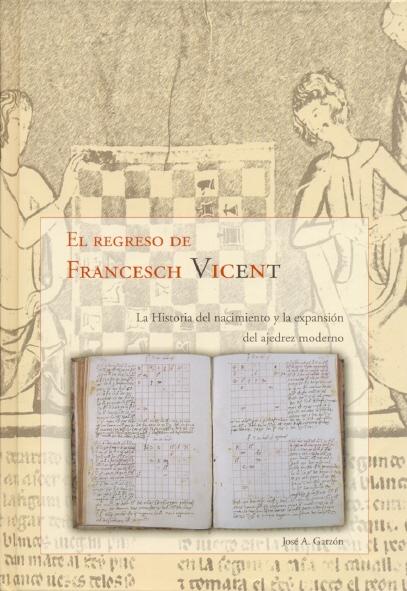
There have been few chess books more attractively produced than El Regreso de Francesch Vicent, which has been published in English under the title The Return of Francesch Vicent.

The above photograph is of Harold Meek, reproduced from page 4 of the British Chess Federation’s Year Book 1938-1945 (Leeds, 1946).
From D.J. Morgan’s obituary of Meek on pages 13-14 of the January 1955 BCM:
‘It was his proud boast to have started, in 1929, the world’s first daily chess column, in the London Evening Standard; later he transferred to the London Evening News, a column which he edited till the end.’
Whereas Meek’s entry in the 1987 edition of Jeremy Gaige’s Chess Personalia recorded that he was born in 1865 in Gloucestershire, the privately-circulated 1994 edition gave 13 October 1885, in Westbury on Severn (Gloucestershire). That latter date matches the statement on the inside back-cover of the December 1954 BCM that Meek died at the age of 69.
On the subject of the British Chess Federation Year-Book we add that pages 217-235 of the 1953-54 edition had an article which is a valuable aid to research: ‘The British Chess Federation – Fifty Years in Retrospect’ by D.J. Morgan.

A very well-known name in the chess world, but who is she?
Luca D’Ambrosio (Bolzano, Italy) mentions a tournament in Meran in 1924 which occasioned the term ‘unofficial European women’s champion’ on page 4 of the Meraner Zeitung of 26 January 1924:
‘Eine geradezu sensationelle Veranstaltung aber ist das Damenturnier, das Meldungen der besten Spielerinnen des Kontinents und Englands in einer in Europa bisher noch nie gesehenen Besetzung aufweist. Die Siegerin des Turniers darf sich getrost als inoffizielle Europameisterin bezeichnen.’
The final standings were: 1-2 Cotton and Holloway (England) 5½; 3 Stevenson (England) 5; 4 Michell (England) 3½; 5 Kalmar (Austria) 3; 6-7 Gülich (Czechoslovakia) and Pohlner (Austria) 2½; 8 König (Germany) ½.
Of the successful players in Meran, Miss Cotton is probably the least known. Our correspondent notes that she was named in the Kurzeitung und Fremdenliste Meran Nr. 24 of 16 February 1924 (page 3) as ‘Cotton-Meirchin Charlotte Helene, Private, London’.
The crosstable was given on page 104 of Schachjahrbuch 1924. I. Teil by L. Bachmann (Ansbach, 1925). Page 129 of the April 1924 BCM reported that after the tournament three of the participants (Holloway, Cotton and Stevenson) defeated three others (Kalmar, Gülich and Pohlner) in a double-round London v Vienna match which the magazine described as a ‘unique event, we believe, in chess history’. Noting Miss Cotton’s death, page 92 of the March 1929 BCM remarked that ‘on various occasions she competed in the British women’s championship’. We should like to present one or two good games by her.
Michael Lorenz (Vienna) has discovered information about Adolf Zinkl’s death:
‘At the time of his death on 3 June 1944, at the age of almost 73, Adolf Zinkl was a retired employee of the postal service (Reichspost). His last address, as recorded on his Todfallsaufnahme, was Erdbergstraße 53/2 in Vienna’s third district. He was survived by his widow Rosina Zinkl née Raith (aged 79) and left no children or other relatives.
Zinkl was buried on 9 June 1944 in Vienna’s Zentralfriedhof (group 41/F, row 13, no. 15). The existence of his grave is guaranteed “auf Friedhofsdauer” (i.e. as long as the cemetery exists).’
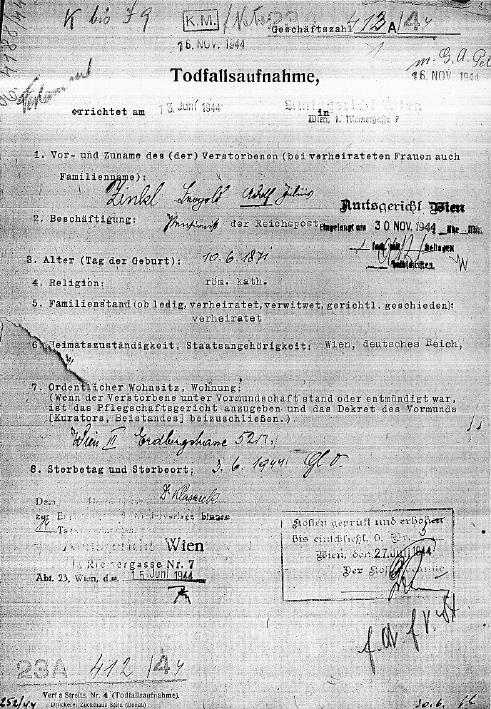
Two further documents from Michael Lorenz (Vienna) regarding Adolf Zinkl are given below, the first being an Einantwortungsurkunde (certificate of inheritance):
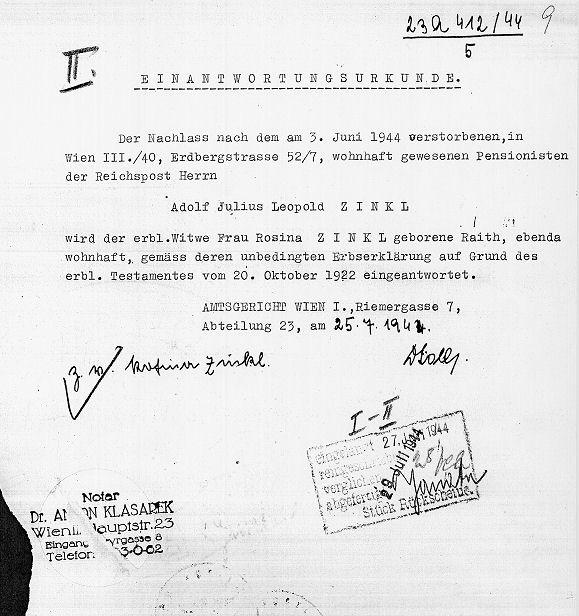
The other document is Zinkl’s will, dated 20 October 1922:
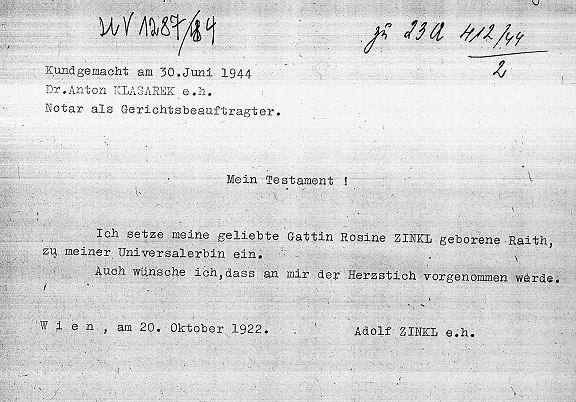
The Herzstich reference is notable.
Below is a portrait of Zinkl, from page 82 of The Rice Gambit (souvenir supplement to the 1905 American Chess Bulletin):
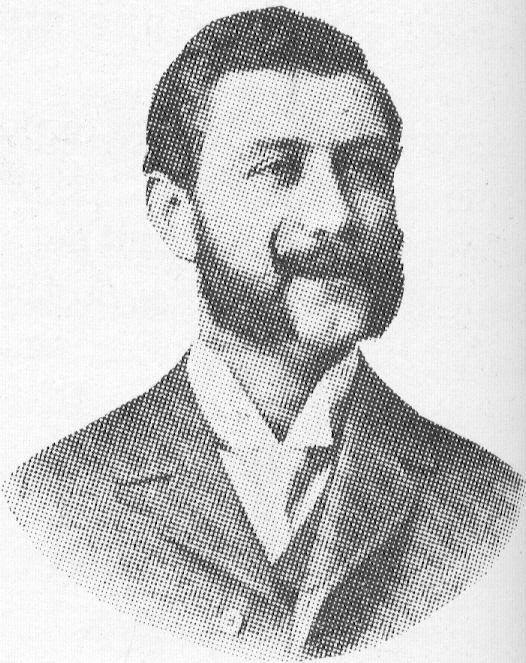
John Donaldson (Berkeley, CA, USA) reports that George Koltanowski’s first chess column in the San Francisco Chronicle was published on page 7L of the 9 May 1948 issue. The top part is reproduced here:
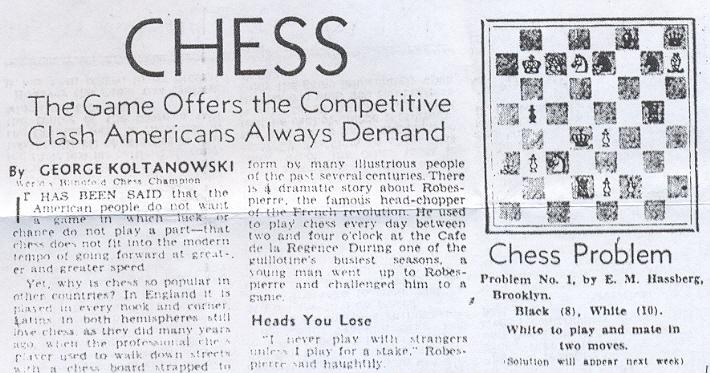
Koltanowski continued the column until his death in February 2000, i.e. for a total of almost 51 years and nine months.
C.N. 4772 dealt with the famous Nimzowitsch v Sistemsson parody, and now Javier Asturiano Molina (Murcia, Spain) mentions a fantasy game between ‘Aaron Marshall’ and ‘Frank Nimzowitch’: 1 e4 a6 2 Bc4 Nh6 3 Bb3 Nf5 4 Be6 Na7 5 Qh5 Resigns 6 Drawn.
It was published on pages 121-122 of Ajedrología by Julio Ganzo (Madrid, 1971):
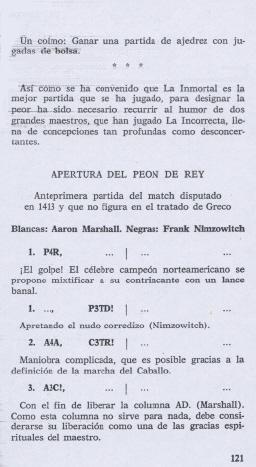

Had the spoof already been published elsewhere?
C.N.s 3974 and 4460 discussed at length Steinitz’s assault on The Chess Openings by Robert B. Wormald (London, 1875) in the City of London Chess Magazine, November 1875, pages 297-304, and December 1875, pages 331-336. That periodical was edited by W.N. Potter, and it is worth adding that on pages 240-245 of the July 1883 BCM he reviewed Chess Life-Pictures by G.A. MacDonnell (London, 1883) and commented:
‘What is said about Wormald is brief, but attractive. I have always regretted allowing Mr Steinitz’s attack upon Mr Wormald to appear in the City of London Chess Magazine. I had habitually accorded to my co-operators an independent expression of their views; but there is little doubt that in this particular instance I ought to have refused to insert the review in question.’
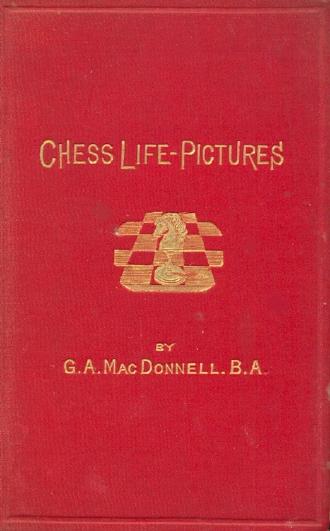
Below are some more quotes from Potter’s review of Chess Life-Pictures mentioned in C.N. 4843:
- ‘The author has evidently a great admiration of Staunton, and the consequence is a portrait painted in the brightest colours, virtues exaggerated, faults minimized, and gravest flaws suppressed. Very graceful and attractive is such magnanimity on Mr MacDonnell’s part for he was at one time violently, not to say virulently, attacked by the object of his laudation. Horwitz says of Staunton, “I never liked his principles, but he was always a man”. The author quotes and tries to attenuate this criticism; but Horwitz meant what he said, and I think all impartial judges must agree with him. Staunton, however, had splendid talents and, what is much to his credit, they were self-cultivated. The sketch given of him in this book, though highly coloured, is so far real that it gives us a good idea of Staunton in many respects and particularly in those mannerisms and characteristics which constitute the visible man.’
- ‘What the author has to say about Harrwitz is particularly interesting. Some of the best writing in the book is contained in this sketch; and yet there is an after feeling of dissatisfaction. Notwithstanding all that is said we do not seem to understand what kind of man he was. No blame can be imputed to the writer. Harrwitz was evidently not one to disclose his inner self. I met him once or twice four or five years back when he emerged from the Tyrol to revisit London and rather liked him. I had formed of him the notion that he had a metallic character, with the glitter and the hardness. He did not answer to this conception. It speaks well for him that he has retired from the world to woo Nature in the Tyrolese mountains, and I suppose she is nowhere lovelier. This may have softened him, and perhaps he was never really the bright steel sword that he seemed.’
- ‘What is said about Henry Thomas Buckle must interest everyone. I remember when I entered the chess world in 1867 hearing much talk about a Mr Buckle and his remarkable ability as a chessplayer. I never for a moment imagined that this Buckle and the Buckle, who had roused England by his ideas about civilization, were one and the same man. Ultimately finding out that such was the case my astonishment was great. The dictum of such a competent judge that chess is not a criterion of intellectual capacity ought to quench the conceit of men eminent in nothing but chess. Has it done so? Certainly not. Self-admiration is as a tape-worm of the brain. It particularly infests chessplayers and is rarely eradicated ...’
A photograph of Potter was given in C.N. 4554, which reproduced an article about him by G.H. Diggle.
C.N. 2756 (see pages 132-133 of A Chess Omnibus) quoted R.C. Griffith’s attempts to refute claims that he ever won this game: 1 e4 e5 2 Nf3 Nc6 3 Bb5 Nf6 4 d3

4...Ne7 5 Nxe5 c6 6 Nc4 cxb5 7 Nd6 mate. The miniature is, however, still frequently attributed to him, even today.
James Mortimer played 4...Ne7 on three occasions at London, 1883, the first being against Rosenthal on 7 May. Later in the event Zukertort essayed it against Englisch and wrote on page 22 of the tournament book, ‘Mr Mortimer claims to be the inventor of this move. I adopted it on account of its novelty’.
We note, though, that the following had appeared on page 147 of the April 1883 BCM:
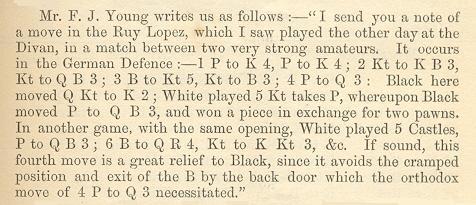
Was Mortimer one of the ‘two very strong amateurs’?
4...Ne7 was also played by C.E. Ranken against W.E. Vyse in the Vizayanagaram tournament at London, 1883 (Chess Player’s Chronicle, 24 October 1883, pages 166-167). For further information on Mortimer’s trap, see Bent Larsen’s article ‘So manchen wilden Pfad’ on pages 10-17 of Kaissiber, July-September 2005.
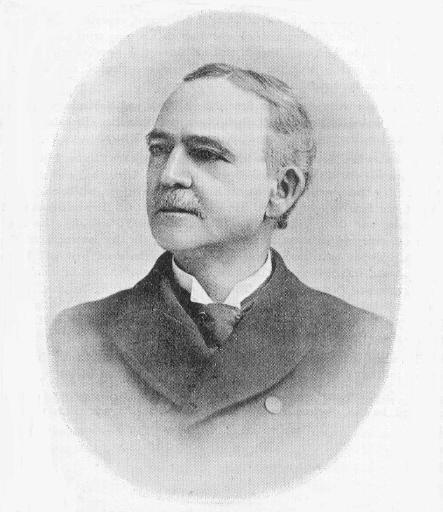
James Mortimer
C.N. 2806 (see page 69 of Chess Facts and Fables) referred to Paul Morphy’s agreement in 1859 to write a chess column for one year in the New York Ledger for $3,000, and we charily suggested a modern-day equivalent of $63,500.
Morphy’s column was discussed by W.J.A. Fuller in a letter to Thomas Frère published in the programme for the 1886 world championship match between Steinitz and Zukertort and reproduced on pages 282-285 of the July 1886 BCM. Below is the complete text of Fuller’s remarks on the subject:
‘Robert Bonner, at that time, was in the first flush of success with his N.Y. Ledger. He paid the highest prices for the best work – ten thousand dollars to Edward Everett for one column a week for a year – some fabulous sum to Charles Dickens for an original story, etc., etc. With his keenness, wide awake to everything that was on the topmost wave of popular favour and universally known, and with his intention to have the best that money could secure for his paper in every department, he thought he saw an advantage, at least in the way of advertising, in having a chess column for the Ledger, edited by Morphy.
Accordingly he engaged Morphy to edit his chess column for a year. The negotiation was made through me. Mr Bonner paid him in advance, with his usual unparalleled liberality, and for one year the Ledger had a chess column. Morphy was incorrigibly lazy, and Mr Bonner would not continue his services at any price for another year. Moreover, his readers were not particularly interested in chess. They cared more for Sylvanus Cobb’s stories, like “The Gun-Maker of Moscow”, than they would for Shakespeare’s Hamlet. There were some things connected with this chess column that were curious, and would greatly interest chessplayers, but it would be contrary to the lex plumae to reveal them without Mr Bonner’s consent. It is more than a quarter of a century since I used to see Mr Bonner on the top floor of the building corner of Ann and Nassau Streets, where I wrote for the Mirror, and he published the Merchants’ Ledger. The absorbing labours of a busy profession have kept us apart. People run in grooves in large cities, and our paths have been as divergent as the poles. Friends are like garden plants and should be cultivated, but I hope Mr Bonner feels as kindly to me as I do to him. His liberality to me was astounding. I shall never forget it. At that time a check for a thousand dollars looked to me as big as a cathedral.’
Some extracts from Fuller’s letter were quoted on pages 95-96 of Morphy Gleanings by P.W. Sergeant (London, 1932) and the ‘incorrigibly lazy’ quote was given by David Lawson on page 231 of Paul Morphy The Pride and Sorrow of Chess (New York, 1976).
Morphy New York Ledger Chess Columns 1859-1860 (Yorklyn, 1987) provided a complete set of photographic reproductions of the columns.

Issue of 16 July 1859
Finally, as regards Charles Dickens’ contribution to the New
York Ledger, pages 895 and 912-913 of Dickens by
Peter Ackroyd (London, 1991) state that in 1859 he received from
Robert Bonner £1,000 for a short story, Hunted Down. At
the time that was approximately $5,000.
Martin Spies (Munich, Germany) asks about the final page of the book Russians versus Fischer, which was published by Chess World Ltd., Moscow in 1994. It carried an announcement for ‘The next item in our series “Chess books”’:
‘Soviet Chess: Onstage and Backstage
The author of this book is Grandmaster Yuri Averbakh, a well-known chessplayer and writer, who has for over 30 years been at the head of the magazine Shakhmaty v SSSR, now The Chess Herald.
All these years he was a leading figure in the USSR Chess Federation. In his memoirs he speaks in a lively and engaging manner about chess activities in the former USSR, discloses many hitherto unknown facts, describes how ideology and politics influenced chess, and, vice versa, how some chessplayers exploited ideology and politics to further their own interests.’
We have no knowledge of such a book in English, but in 2003 Averbakh’s memoirs appeared in Russian under the title Shakhmaty na stsene i za kulisami.
To the many instances of mistaken identity noted over the years (see the Factfinder) Javier Asturiano Molina (Murcia, Spain) adds a striking one, from page 222 of El Ajedrez by J. Martí (first published in Barcelona in 1969):

The longevity of that particular Leonardo and the dates concerning Labourdonnais, Philidor, Botvinnik, Smyslov and Tal are a bonus.
Dale Brandreth (Yorklyn, DE, USA) writes:
‘For many years I have owned Alekhine’s copy of the famous tournament book on Carlsbad, 1907 by Marco and Schlechter. On the spine it has “A.A.” stamped, and on the endpapers there is a note in the hand of Albert Pinkus stating that he acquired the book in June 1949.’
Can readers help in deciphering the marginalia on the two pages below, concerning the games Johner v Rubinstein and Janowsky v Schlechter?
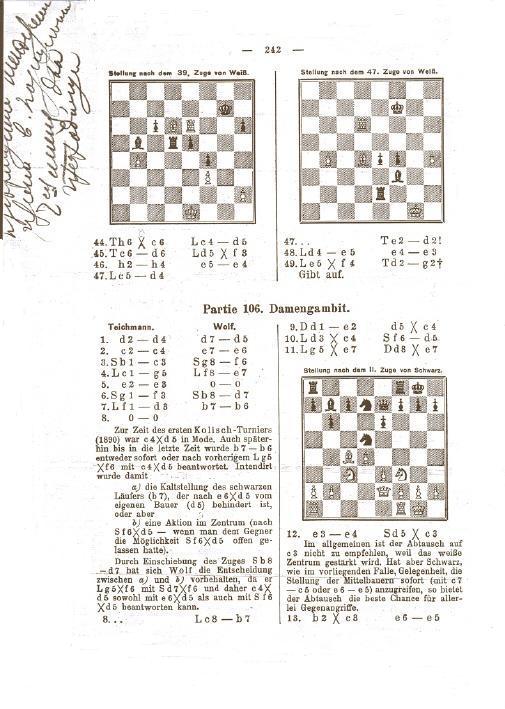


This is the chess patron Clare Benedict (1871-1961), in a photograph taken from her book “The Benedicts Abroad” (London, 1930).


Referring to the attempts in C.N.s 3344 and 3357 (see page 297 of Chess Facts and Fables) to establish whether Mecking’s birth-date was 23 January or 2 February 1952, Christian Sánchez (Rosario, Argentina) writes:
‘Page 9 of Mecking’s book O Encontro do Século Fischer x Spassky (São Paulo, 1973) gives his birth-date as 23 January 1952 and place of birth as Santa Cruz do Sul, Rio Grande do Sul. It would be logical to suppose that this biographical introduction, although in the third person, was written by him or, at least, approved by him.’
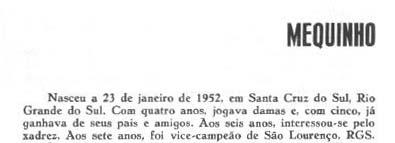
Two of Morphy’s (relatively well-known) opponents wrote books about trade. Who were they?
Wanted: ingenious chess-related clues published in crossword puzzles. By way of example, below are three non-chess clues; the first two were reported on pages 100 and 101 of the Chambers Crossword Manual by Don Manley (Edinburgh, 2006), whereas the third one we recall from decades ago:
Country with its capital in Czechoslovakia (6)
HIJKLMNO (5)
(7)
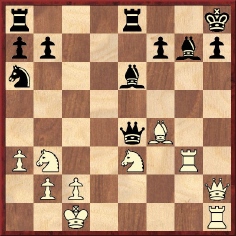
White to move and win
A.R.B. Thomas (1904-85) gained a dose of immortality through being quoted by Bobby Fischer in My 60 Memorable Games (New York, 1969). This occurred in his notes to the second match-game between Fischer and Reshevsky in 1961 (game 26), of which the conclusion is reproduced below:

The logic of the note is unclear. Since 28 Rxg7 receives an exclamation mark, it might even be inferred that Fischer’s comment ‘Right, Mr Thomas!’ was sarcasm. Puzzlement over this matter was, understandably, expressed by a reader on page 66 of the February 1989 Chess Life. Page 267 of ‘Garry Kasparov on Fischer My Great Predecessors Part IV with the participation of Dmitry Plisetsky’ (London, 2004) gave ‘28 Rxg7!? (28 Nd2!)’.
Thomas’ letter in CHESS was published on page 249 of the Easter 1966 issue:
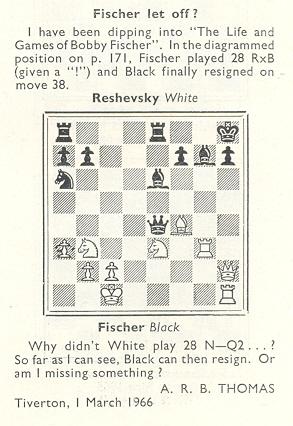
The book to which Thomas was referring was the Fischer biography by Frank Brady (Profile of a Prodigy), published the previous year. There is, though, a curiosity, as Thomas was not the first person to suggest 28 Nd2. Indeed, he was not even the first in CHESS. Several years earlier, on page 409 of the October 1961 issue, the following appeared:

The solution on page 416:

From the entry on Georg Marco (by Wolfgang Heidenfeld) on page 190 of The Encyclopedia of Chess by Harry Golombek (London, 1977):
‘... Marco has left an imperishable chess legacy in his brilliant and witty annotations.’
A general article about Marco appeared on pages 65-70 of CHESS, end-November 1963 (‘The Prince of Annotators’ by Dale Brandreth), but has anyone ever compiled a selection of his best observations (with exact sources)?
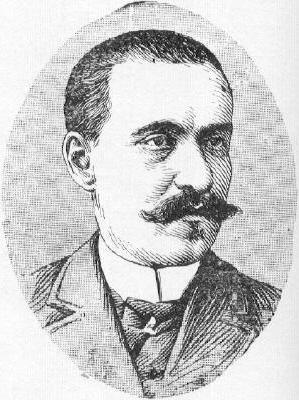
Georg Marco
Martin Weissenberg (Savyon, Israel) writes:
‘On page 9 of his book Richard Réti, šachový myslitel (Prague, 1989) Jan Kalendovský mentioned that Richard Réti was born in 1889 in Pezinok to Samuel Réti from Hlohovec and to Anna, née Mayerova, in a Pezinok Jewish family.
Richard’s brother Rudolph (1885-1957), a noted Viennese concert pianist, composer and musicologist, emigrated to the United States in the late 1930s and subsequently became an American citizen. His papers and the chess manuscripts and notes of Richard Réti are held at the Library of Congress.
Richard Réti is listed as a Jewish chessplayer in the Encyclopedia Judaica (Jerusalem, 1973) – see pages 401-409 of volume five and page 103 of volume 14 – but the chess editor, Gerald Abrahams, did not provide supporting references for his text.’
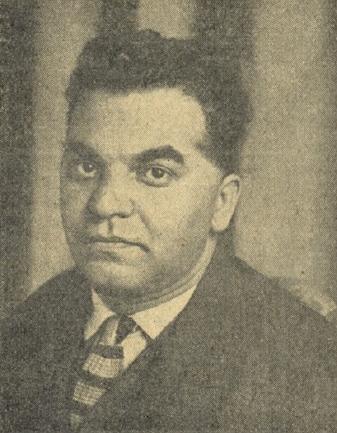
Richard Réti
For Rudolph Réti’s reminiscences of his younger brother, see pages 373-381 of A Chess Omnibus.
C.N. 1928 (see page 230 of Chess Explorations) suggested that Bruce Pandolfini broke new ground on page 36 of Chess Openings: Traps and Zaps (New York, 1989) by indicating that Rudolf Spielmann lived to be 109:

In fact, the following had already appeared on page 158 of Grandmasters of Chess by Harold C. Schonberg (Philadelphia and New York, 1973):

‘Roy Lopez’ appeared on the front cover of lesson XV in Fred Reinfeld’s series A Course in the Elements of Modern Chess Strategy, but Richard Reich (Fitchburg, WI, USA) notes that some of the pamphlets were reprinted several times and that his copy has the correct spelling.
We had before us the ‘Second Printing, September 1938’:
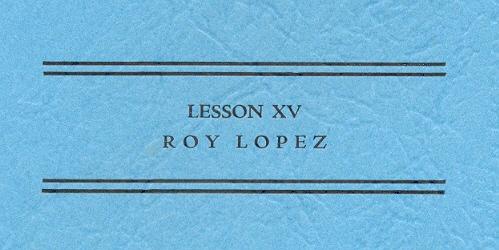
Our correspondent also mentions that lesson XXIV invited subscriptions for an additional four issues, whereas Douglas A. Betts’ Annotated Bibliography (pages 197-199) indicates that XXIV was the last to be published. For our part, we have never seen any subsequent issues.
Lesson XXIV (‘First Printing, December 1938’) was devoted to the Tarrasch Variation in the Ruy López and included on pages 11-12 an early postal victory by Reinfeld:
Fred Reinfeld – Narraway1 e4 e5 2 Nf3 Nc6 3 Bb5 a6 4 Ba4 Nf6 5 O-O Nxe4 6 d4 b5 7 Bb3 d5 8 dxe5 Be6 9 c3 Be7 10 Be3 O-O 11 Nbd2 Bg4 12 Nxe4 dxe4 13 Qd5 exf3 14 Qxc6 fxg2 15 Qxg2 Qd7 16 Rfe1 c5
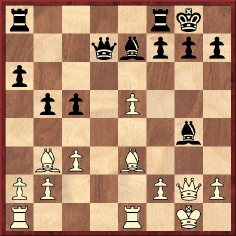
17 Bh6 gxh6 18 e6 Qc8 19 exf7+ Kh8 20 Rxe7 Bh3 21 Qd5 Qg4+ 22 Kh1 Qg5 23 Rg1 Bg4 24 Rxg4 Resigns.
We believe that Fred Reinfeld’s first non-chess book was an abridgment of Oliver Twist (New York, 1948). The front cover featured John Howard Davies in the title role in the film version released the same year, and the last two pages (313-314) had an Afterword by Reinfeld about Dickens’ life and work.
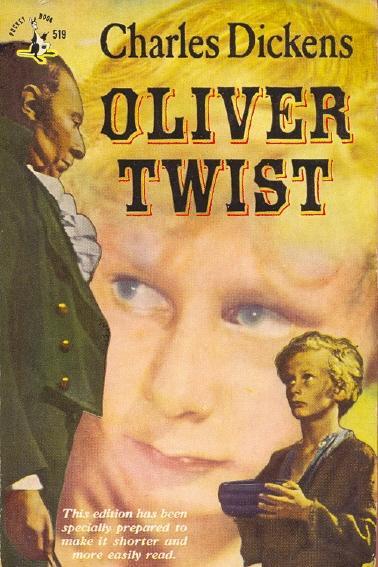

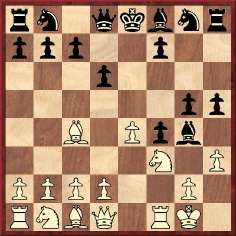
C.N. 4792 gave a game between J.F. Lansing and R.A. Hart which began 1 e4 e5 2 f4 exf4 3 Nf3 g5 4 Bc4 d6 5 O-O Bg4 6 h3 h5, and information is now sought on the origins of this line, the ‘Middleton Counter-Gambit’. The game below was presented on page 267 of the June 1908 Chess Amateur:
R.A. Hart – P.H. Seamon1 e4 e5 2 f4 exf4 3 Nf3 g5 4 Bc4 d6 5 O-O Bg4 6 h3 h5 7 hxg4 hxg4 8 Nd4 g3 9 Qg4 d5 10 exd5 Bc5 11 Re1+ Kf8 12 c3 Nh6 13 Qe2
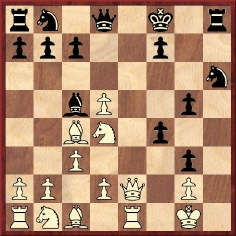
13...Nc6 14 dxc6 Bxd4+ 15 Kf1 Nf5 16 Qe4 Qf6 17 cxb7 Rb8 18 Ke2 Bf2 19 Rf1 Kg7 20 Kd1 Rbe8 21 Qd5 Rd8 22 Qxf7+ Qxf7 23 Bxf7 Ne3+ 24 Ke2 Nxf1 25 Bc4 Rhe8+ 26 White resigns.
A note at White’s eighth move mentioned ‘an American leaflet on this opening which gives four specimen games’. Does any reader have a copy?
Page 173 of the March 1909 Chess Amateur referred to ‘this remarkable opening’ when giving another game played in America, contributed by S. Reid Spencer and annotated by W.P. Turnbull:
N.N. – Lohmann1 e4 e5 2 f4 exf4 3 Nf3 g5 4 Bc4 d6 5 O-O Bg4 6 h3 h5 7 hxg4 hxg4 8 Nd4 Qf6 9 c3 d5 10 Qxg4 Nd7 11 exd5 Bc5 12 Re1+ Ne7 13 d3 Ne5 14 Qe2 f3 15 Qf2
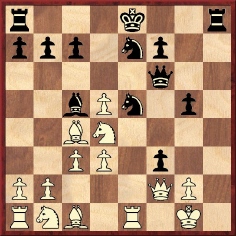
15...Rh2 16 Kxh2 Ng4+ 17 Kg3 Nxf2 18 Kxf2 fxg2+ 19 Kxg2 O-O–O 20 Be3 g4 21 Nd2 Bd6 22 Ne4 Qe5 23 Nxd6+ cxd6 24 Bf2 Qg5 25 Re3 Ng6 26 Rae1 a6 27 a4 Kd7 28 Bg3 Rh8 29 b4 Rh3 30 Kf2 f5 31 Ne6 Qh6 32 a5
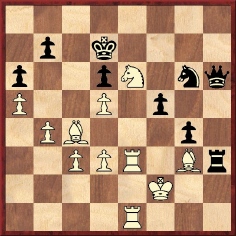
32...Rxg3 33 White resigns.
When a third game was published on pages 77-78 of the December 1909 Chess Amateur, again with notes by W.P Turnbull, the players were not identified, although it was stated that this score too had been contributed by S. Reid Spencer:
N.N. – N.N.1 e4 e5 2 f4 exf4 3 Nf3 g5 4 Bc4 d6 5 O-O Bg4 6 h3 h5 7 hxg4 hxg4 8 Nh2 g3 9 Ng4 Qe7 10 Re1 f6 11 Bxg8

11...Nd7 12 Bd5 Qh7 13 Kf1 Qh1+ 14 Ke2 Qxg2+ 15 Kd3 Nc5+ 16 Kd4

16...Bg7 17 Kc4 c6 18 Bxc6+ bxc6 19 Rg1 Qxe4+ 20 d4 Qd5+ 21 Kc3 Na4+ 22 Kd3 Qb5+ 23 Kd2 O-O-O 24 Na3 Qf5 25 b3 Qa5+ 26 White resigns.
As yet we have not ascertained why the name Middleton was applied to the gambit. It may be a reference to E.E. Middleton, who was active in Belgian chess circles in the first decade of the twentieth century, but can a reader take the matter further?
Yossy Fallakh (Or-Yehuda, Israel) recalls the game between L. Pachman and J. Timman, Geneva, 1977:
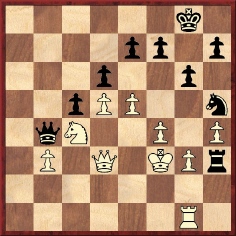
Play went 40...Qe1 41 Qxg6+, and the game was eventually drawn. Pachman annotated the conclusion on pages 310-311 of the July 1977 BCM, and it should be noted that some modern sources misdate the game 1978.
C.N. 2535 (see page 358 of A Chess Omnibus) cited the following from page 176 of the November 1920 American Chess Bulletin:
‘According to H.A. Horwood of Los Angeles, Cal., in the October “Folder” of the Good Companion Chess Problem Club, Carlos Torre, R., the boy expert of New Orleans, like Rzeschewski, has appeared in the “movies”.’
No further information has yet been found, and for now we can but add the exact text in the earlier publication:
‘H.A. Horwood, Los Angeles, Calif. “These are wonderful days for chess, as I saw last evening, in a moving picture theatre, an exhibition of our boy wonder, C. Reperto [sic], of New Orleans.”’
Source: “Our Folder”, 1 October 1920, page 11.
Macon Shibut (Vienna, VA, USA) notes that a remark often attributed to Botvinnik begins ‘every Russian schoolboy knows that ...’ What is the first known occurrence of this phrase in a chess context?

Mikhail Botvinnik
From Neil Brennen (Spring City, PA, USA):
‘The Middleton Counter-Gambit is named after Thomas J. Middleton of Texas. I mentioned this in passing in my article “The Process of Creation”’.
Our correspondent’s article quoted from a feature ‘Chess in Texas By a Texan’ on page 171 of the October 1898 American Chess Magazine, which stated:
‘Mr T.J. Middleton, of Waxahachie, ... has played chess since 1870, is very original in his games, always seeking new lines of play. He has originated a reply to the King’s Gambit wherein Black sacrifices a bishop on the sixth move, that has attracted some notice among Texas players.’
A small photograph of Middleton appeared on the same page of the American Chess Magazine:
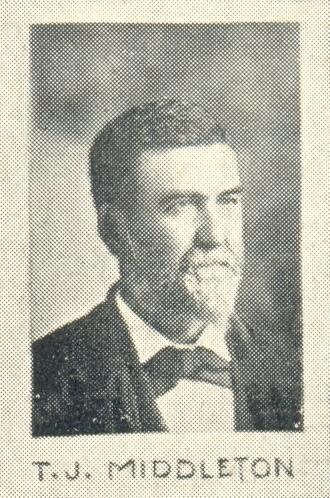
Books about trade were written by Morphy’s opponents George W.
Medley and Augustus Mongredien. For example:
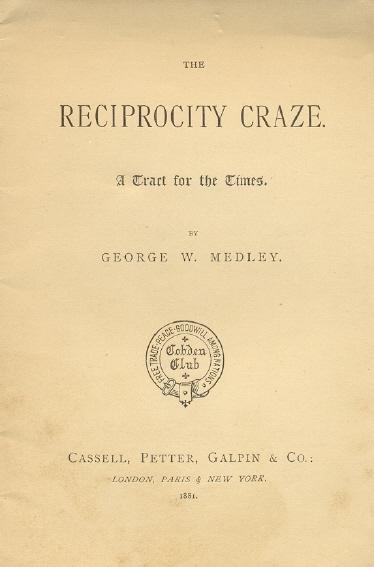
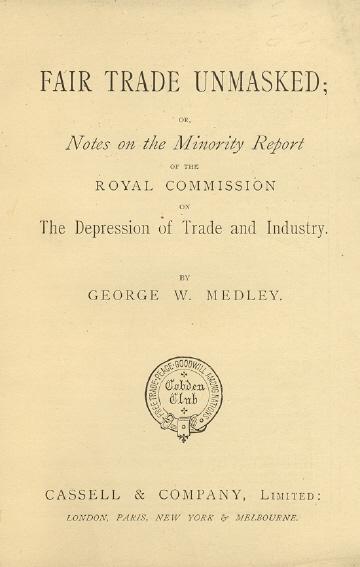
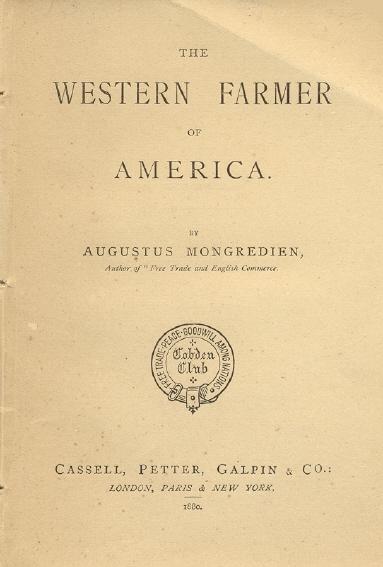

C.N.s 2983 and 2998 (see pages 46-50 of Chess Facts and Fables) gave 18 forgotten games from Schaakkalender van het Noordelijk Schaakbond 1883 (Assen, 1883), including one played in Rotterdam on 22 October 1881 which, we stated, was between C.E.A. Dupré and James Mason. We are very grateful to Joost van Winsen (Silvolde, the Netherlands) for pointing out that, as indicated on page 77 of the Schaakkalender, Black was J.H. Zukertort.
Jonathan Hinton (East Horsley, England) refers to Bertok v Fischer, Stockholm, 1962, which is game 34 in Fischer’s My 60 Memorable Games. It began 1 d4 d5 2 c4 e6 3 Nc3 Be7 4 Nf3 Nf6 5 Bg5 and continued:
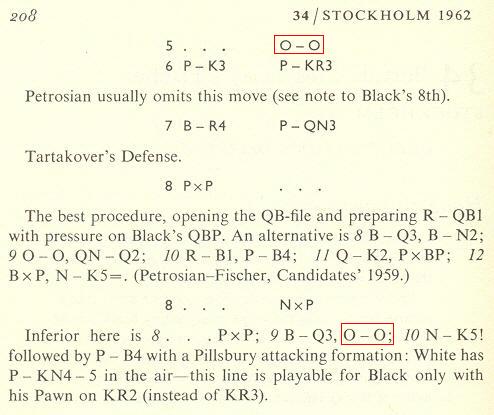
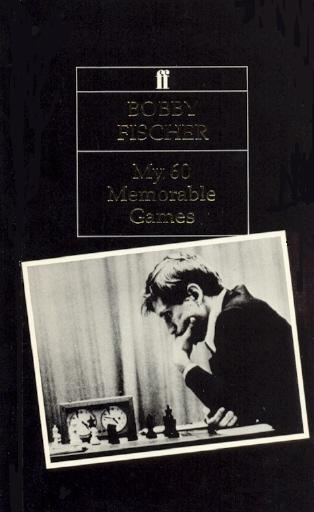 Our correspondent
comments, firstly, that the note at Black’s eighth move is
faulty: 9...O-O is not possible, since Black has already
castled. Secondly, he points out that his 1988 Faber and Faber
edition of the book (a paperback with a black cover) attempted
to correct the mistake but made matters worse: instead of ...O-O
being changed to ...B-N2 in the note to Black’s eight move, that
alteration was introduced, impossibly, in the score of the game,
at move five:
Our correspondent
comments, firstly, that the note at Black’s eighth move is
faulty: 9...O-O is not possible, since Black has already
castled. Secondly, he points out that his 1988 Faber and Faber
edition of the book (a paperback with a black cover) attempted
to correct the mistake but made matters worse: instead of ...O-O
being changed to ...B-N2 in the note to Black’s eight move, that
alteration was introduced, impossibly, in the score of the game,
at move five:
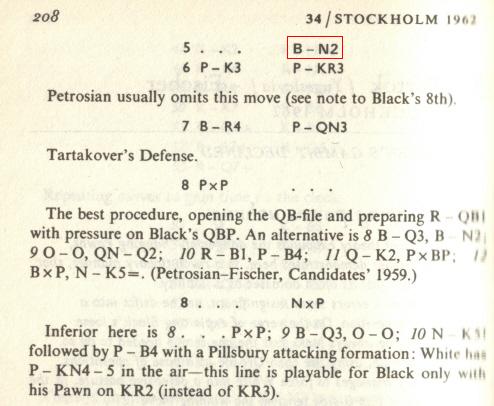
We add a complication: our own copy of the 1988 ‘black edition’ is slightly different from Mr Hinton’s (on the back cover they are priced at £4.95 and £7.99 respectively). Our copy still has ...O-O in both places.
It seems that only the 1995 Batsford edition (page 130) has this matter correct: 5...O-O in the game-score and 9...Bb7 in the note at move eight.

Siegbert Tarrasch
C.N. 4367 asked for information about a term ascribed to Tarrasch, ‘Remismonde’, and we now note the following on page 63 of the August 1898 American Chess Magazine:
‘Personally, he [Tarrasch] is a gentleman of the world, with the most elegant of manners; genial, sarcastic, witty and sharp-tongued. “Ah!”, he exclaimed once, when the dear Viennese again brought about a “draw”. “I am here in Vienna among the ‘Remismonde’.” “It is not sufficient to be a good chessplayer, one must play good chess”, is one of his favorite sayings.’
The writer was Armin Friedmann in Pester Lloyd, 20 or 21 June 1898. The original German version was given on page 346 of the Vienna, 1898 tournament book:
‘Persönlich ist Dr Tarrasch ein Weltmann von feinsten Manieren, geistreich, boshaft, witzig, scharfzüngig. “Ach ich verkehre hier nur mit der Remismonde”, seufzte er jüngst, als die lieben Wiener nach ihrer Gewohnheit sich wieder einmal ausglichen. “Es ist nicht genug, dass man ein guter Spieler ist, man muss auch gut spielen”, lautet einer seiner Aussprüche.’
Spoof variants on the ‘good chessplayer’ dictum were discussed on pages 396-397 of Kings, Commoners and Knaves, but what earlier citations can be found for Tarrasch’s own words?
Peter Anderberg (Harmstorf, Germany) submits the game between Henningsen and R. Borik, as published on page 161 of Schach-Echo, 1979:
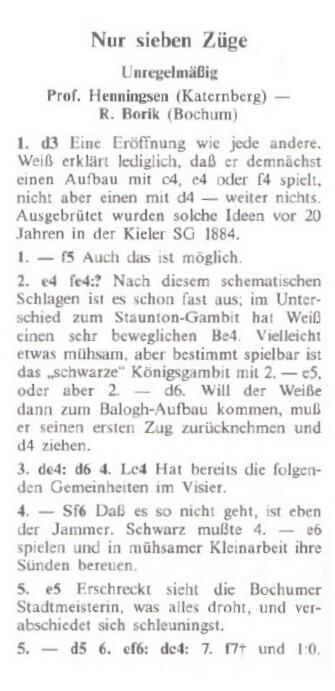
An obituary stated that ‘a man of his literary distinction is an honour to the game’. He was a nineteenth-century figure who died in his sixties and was known not only for his activity in the chess world (e.g. the Chess Player’s Chronicle and the Illustrated London News) but also for his writings on Shakespeare as from circa 1860.
From the back cover of The Riddle of the Kremlin by Eileen Bigland (London, 1940):
‘This book is, politically, impartial. Mrs Bigland writes neither as a Communist not as an anti-Red. She is, however, in an exceptionally good position to attempt this study of Stalin’s mentality and the Russian objectives in the European game of chess. She knows Stalin personally and has discussed international questions with him frankly and at length.’
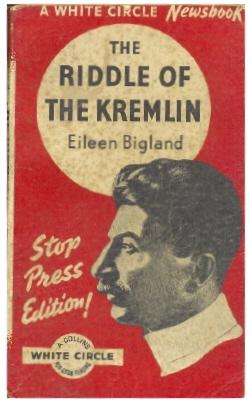
Chapter five (pages 80-100) is entitled ‘A Russian plays chess’, and below we quote from page 91:
‘Most Russians learn chess in childhood; probably Yosif Stalin was no exception, although there is no record of his being an infant prodigy at the difficult game. He must have been a superb player, however, by the time he was able to say “Checkmate” not to his opponent’s king but to his own god, Lenin, and ever since the fateful Treaty of Versailles his favourite form of relaxation had been to play a subtle little game in which the various European nations were the white men, he and his satellites the black. Until 1936 the game remained the merest hobby, but the Georgian had learnt long ago how to turn knowledge gained through a hobby (vide Caucasian banditry) to real use should necessity arise.’
Steve Giddins (Rochester, England) recalls an old chess-related crossword clue, whereas the second specimen below is one we noted with a frown in puzzle 48 in Chipwinkle by Hubert Phillips (West Drayton, 1947):
Dramatic example of smothered mate (9)
As Ruy Lopez might have said: ‘From see to see’ (7, 4)
An easier one than usual:
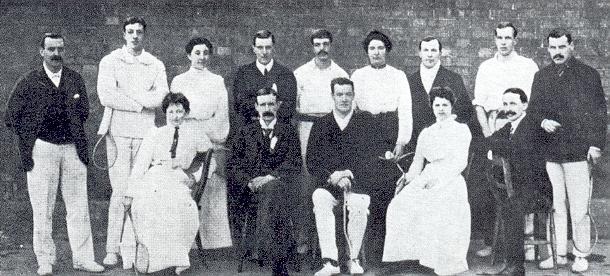
| First column | << previous | Archives [31] | next >> | Current column |
Copyright 2007 Edward Winter. All rights reserved.